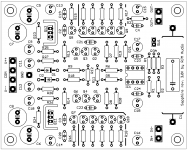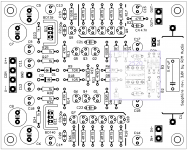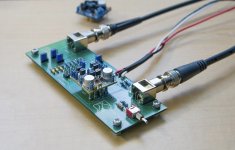I fixed the BOM,
R4 660-MF1/4DC2211F (2.21k) => 660-MF1/4DC2212F (22.1k)
and have uploaded the corrected version to the web page.
The copy paste error happened recently when I changed the BOM to use the KOA resistors. Sorry! Older versions used Vishay p/n which were correct.
Richard
R4 660-MF1/4DC2211F (2.21k) => 660-MF1/4DC2212F (22.1k)
and have uploaded the corrected version to the web page.
The copy paste error happened recently when I changed the BOM to use the KOA resistors. Sorry! Older versions used Vishay p/n which were correct.
Richard
Attachments
I've sold out of the first batch of Sapphire 3.0 boards (they proved relatively popular...) and will soon re-order.
I have the option of doing a re-spin [aka a new tooling of the layout], but there weren't any issues with version "f" except that C9,10 ended up unused. So unless there are things anyone else encountered I'll probably just go with a straight re-order using the previous tools.
Anything you want changed?
I have the option of doing a re-spin [aka a new tooling of the layout], but there weren't any issues with version "f" except that C9,10 ended up unused. So unless there are things anyone else encountered I'll probably just go with a straight re-order using the previous tools.
Anything you want changed?
Attachments
Personally, I'd like an API-2520 foot print aka - DOA foot print around the opamp with the option of raising the default voltage to +-15V so I could use my DIY JE-918, JE-990 and SG-SOA-2 discrete opamps (though most will work at +-12V). See Sam Groner’s web page or MNAT's web page for the opamps.
DIY JE-990 DOA
SG-Acoustics · Samuel Groner · Analogue Audio
Given the costs are pretty reasonable for the kits - around $15 to $18 ea., those are the one's I'd like to try. But, it's not a show stopper.
BTW - my kit arrived yesterday. Thanks!
DIY JE-990 DOA
SG-Acoustics · Samuel Groner · Analogue Audio
Given the costs are pretty reasonable for the kits - around $15 to $18 ea., those are the one's I'd like to try. But, it's not a show stopper.
BTW - my kit arrived yesterday. Thanks!
15 V operation doesn't require modification to the boards, you'd just change the Zener to 15 V, use a transformer with 2x15 V secondaries, and change the capacitors to ones with 35 V rating. (The value would be reduced slightly, but this is no problem.)
2520 footprint, as I understand it, is a square 1.1" (28mm) board. I sketched a rough outline below. Is there a standard pinout or package dimension you could point me to? Does it plug into an 8 pin DIP socket? C17,18,23,24 are not mission critical so if the module could be mounted above the resistors (or move the resistors or the module to the underside of the board) something could probably be done.
2520 footprint, as I understand it, is a square 1.1" (28mm) board. I sketched a rough outline below. Is there a standard pinout or package dimension you could point me to? Does it plug into an 8 pin DIP socket? C17,18,23,24 are not mission critical so if the module could be mounted above the resistors (or move the resistors or the module to the underside of the board) something could probably be done.
Attachments
Last edited:
Best to refer to John Hardy's 990 pdf as there's an outline of the bottom with the pins labeled.. There are 6-pins, Input +/- on one side and Output, V+, Gnd, V- on the other side. The pins are on 0.1" centers. The jacks are 0.40" pins. The original footprint had one more pin - feedback, but it's not used in any of the current designs that I've seen, nor in any of the available kits.
John Hardy's PDF is at -
http://www.johnhardyco.com/pdf/990.pdf
I think I might have an Eagle footprint I downloaded from another site that's no longer there. I'll look for that tonight and if I find it I'll upload it here.
Sockets that would work are -
Mill-Max - 0344-3-19-15-34-27-10-0
Concord Electronics - 09-9055-2-03
Wearnes Cambion, LTD - 450-3756-02-03
Some of the DOA kits come with sockets, some don't. Mouser doesn't stock them, Digikey does. Anyone that would need them can get them with minor effort.
John Hardy's PDF is at -
http://www.johnhardyco.com/pdf/990.pdf
I think I might have an Eagle footprint I downloaded from another site that's no longer there. I'll look for that tonight and if I find it I'll upload it here.
Sockets that would work are -
Mill-Max - 0344-3-19-15-34-27-10-0
Concord Electronics - 09-9055-2-03
Wearnes Cambion, LTD - 450-3756-02-03
Some of the DOA kits come with sockets, some don't. Mouser doesn't stock them, Digikey does. Anyone that would need them can get them with minor effort.
Here's a link to a discrete opamp test jig that shows the DOA-to-DIP relationship and pinouts -
FiveFish Audio - OpAmp Test Jig
I have one at home.
FiveFish Audio - OpAmp Test Jig
I have one at home.
Thanks for the info. I think I have everything I need now.
So I'd do something like the Five Fish Audio test jig (photo below, courtesy of the web page). The op amp sits on sockets above the board, so in principle resistors could be mounted underneath (there is about 5 mm clearance). So all I'd need to do is add the 5 pads and perhaps rethink the capacitor positions.
Hmm. Well, its not often you see a headphone amp with 990 compatibility, it might give the Sapphire some traction in pro-audio circles.
Leave it with me, I'll see what I can do.
So I'd do something like the Five Fish Audio test jig (photo below, courtesy of the web page). The op amp sits on sockets above the board, so in principle resistors could be mounted underneath (there is about 5 mm clearance). So all I'd need to do is add the 5 pads and perhaps rethink the capacitor positions.
Hmm. Well, its not often you see a headphone amp with 990 compatibility, it might give the Sapphire some traction in pro-audio circles.
Leave it with me, I'll see what I can do.
Attachments
There are a few that run the resistors under the opamp. If the height is the same as the opamp socket, it won't hit the bottom of the DOA. However, the DIY 990 has the SSM2212 mounted on the bottom just inside of the +- input pins.
An externally hosted image should be here but it was not working when we last tested it.
Attached is the Harpo_1.lbr that should have the footprint in it. It came from
If you only had one DIY eq you wish to build, which would it be?
If you only had one DIY eq you wish to build, which would it be?
Attachments
On the capacitors - C23 and C24 are always on the DOA, thus would be a no-stuff as would the DIP socket. Even on the adapters, they would be present as would the de-comp capacitor for a NE5534.
An externally hosted image should be here but it was not working when we last tested it.
Thanks for the info. I think I have everything I need now.
So I'd do something like the Five Fish Audio test jig (photo below, courtesy of the web page). The op amp sits on sockets above the board, so in principle resistors could be mounted underneath (there is about 5 mm clearance). So all I'd need to do is add the 5 pads and perhaps rethink the capacitor positions.
Hmm. Well, its not often you see a headphone amp with 990 compatibility, it might give the Sapphire some traction in pro-audio circles.
Leave it with me, I'll see what I can do.
Or better still, make a mark 4 with a discrete front end, preferably jfet
I forgot about a couple of opa627 I have. Put them in last night and it made a very subtle improvement, sound seemed to open up a little.
I also reduced the gain and properly earthed it tidied up cables etc. it made a big difference, much quieter.
Last edited:
JLM Audio, among others, offers a discrete FET opamp in a 2520 footprint. The JLM25HVFET opamp. They are in Australia, so shipping can take a bit. They're at JLM AUDIO.
Some of the other FET based discrete opamps didn't fare to well in Sam Groner's opamp tests. The 35MB pdf file with all the test results are on his web site. He does have a link to Fred Forssell's paper on a JFET discrete opamp design.
Some of the other FET based discrete opamps didn't fare to well in Sam Groner's opamp tests. The 35MB pdf file with all the test results are on his web site. He does have a link to Fred Forssell's paper on a JFET discrete opamp design.
Hi *shadow, I don't really know what 2520 is, but sapphire takes 8 pin dip. I checked out the link and they seem nicely built op amps. Shipping should be quick, it's a 4 hour flight to Sydney or Melbourne from here
I'm not talking about opamps, I'm talking a bout the sapphire output stage with a jfet front end. Jftets, fets, bipolar is personal preference I think, so I would judge based on hearing rather than test results.
I'm not talking about opamps, I'm talking a bout the sapphire output stage with a jfet front end. Jftets, fets, bipolar is personal preference I think, so I would judge based on hearing rather than test results.
Yikes, those OPA627 op-amps are expensive. What makes them so pricey?
Hype
Low volumes, I suppose, and perhaps the difficulty of getting BJT-like DC performance from an integrated FET input stage.
Well, you are talking about op amps you just don't know it yet.
An op amp isn't defined by being an integrated circuit, it's a differential, high open loop gain (voltage) amplifier with global feedback. The OPA134 is an opamp (integrated circuit), those 2520 modules are too (as a discrete, pre-built package) and whatever I would come up for a native Sapphire front end would most likely also fit the description.
My resistance to going down that route is,
1. Board real estate.
2. BOM spiraling out of control.
3. The low ROI on reinventing the wheel.
The John Hardy white paper disfunctionalshadow linked to above makes the best case I've yet read for why discrete op amp should sound better than integrated, but I'm still not convinced the humble OPA134 is so bad in comparison [in the application of the Sapphire circuit...], or that anything I could manage would be substantially better than both.
As for "hype", would you consider $60 US for a MUSES01, essentially a poorly performing OPA2134 variant?
I'm not talking about opamps, I'm talking a bout the sapphire output stage with a jfet front end.
Well, you are talking about op amps you just don't know it yet.
An op amp isn't defined by being an integrated circuit, it's a differential, high open loop gain (voltage) amplifier with global feedback. The OPA134 is an opamp (integrated circuit), those 2520 modules are too (as a discrete, pre-built package) and whatever I would come up for a native Sapphire front end would most likely also fit the description.
My resistance to going down that route is,
1. Board real estate.
2. BOM spiraling out of control.
3. The low ROI on reinventing the wheel.
The John Hardy white paper disfunctionalshadow linked to above makes the best case I've yet read for why discrete op amp should sound better than integrated, but I'm still not convinced the humble OPA134 is so bad in comparison [in the application of the Sapphire circuit...], or that anything I could manage would be substantially better than both.
As for "hype", would you consider $60 US for a MUSES01, essentially a poorly performing OPA2134 variant?
Last edited:
- Home
- Amplifiers
- Headphone Systems
- RJM Audio Sapphire Desktop Headphone Amplifier


